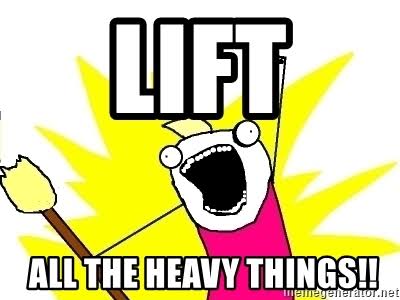When it comes to choosing which exercises to use in your strength training program, we encourage trainees to approach exercise selection with a balance of both pushing and pulling movements for the upper and lower body. This gives you a more complete development and greater overall balance and movement proficiency in a variety of different movement demands.
This usually involves targeting movements and body parts from multiple angles which, aside from symmetry also helps to:
1. Accumulate needed training volume, which is an important factor for building muscle size and strength.
2. Sculpt and shape the body towards ones desired proportions if training goals are more aesthetic driven.
3. Target unpractised or lagging movements and strengthen specific contributing muscles.
We’ll often have new clients show us the strength programs they’ve been using and have put together themselves to get some feedback. Often we’ll see included almost every known exercise variation for a body part that you can imagine in an attempt to cover all angles. This is a fine idea in theory, however, there are a few things to consider when trying to cover all possible angles and one of those considerations is something that I like to call variation preservation.

If you use all of the most productive or favourite exercises in your program, you will have too few exercise variations to choose from or to progress towards once you’ve reached training a plateau and are no longer making the kind of progress you used to on those exercises. The human body is an amazingly efficient and adaptive organism and certainly will, over a short period of time adapt to a given training plan, and this is where you’ll begin to see your progress slow and eventually stop altogether. When this happens, you will need some strategic deviation and a variant go-to exercise that still gives you similar qualities, while offering a fresh stimulus again, and all without losing any of the progress you have built up to this point.
Another more obvious problem with this ‘do everything’ approach is that you may end up doing way more than you need with potentially overlapping and redundant exercises, and subsequently using up more of your valuable recovery ability, that could go towards repair and building.
One of the possible solutions that I often suggest is to do fewer total exercises and more total sets of those exercises. Specifically, pick fewer exercises, but make sure that you use mostly your high return movements and keep a few of them in your back pocket for a later program. Doing more total sets of fewer exercises allows greater focus to be had, and for the beginner lifter in particular, more high-quality technique rehearsal.
- 5 total exercises per session, 3 sets of each exercise, 2 pushing sessions per week (30 total sets)
- Combination of flat, incline, barbell and dumbbell exercises on both pressing days
- 3 total exercises per session, 5 sets of each on each exercise (30 total sets per week)
- Flat or Incline exercises only for 2-3 training cycles
- Barbell or dumbbell exercises only for 2-3 training cycles
You’ll notice that with option 2, you can manage the same total weekly training volume and focus it towards fewer exercises. Option B also offers a complete pressing program and leaves you with plenty of effective variations to utilise once progress begins to slow or stops.
It has been well documented that strength adaptations can drop off at around the 3-4 week mark using the same schedule. From here you may try changing the grip that you use, the set & rep scheme, the rep speed, and even the rest period between sets. Any of these as well an intermittent deload week can provide enough of a small change and a fresh stimulus, and still be fairly consistent enough to make continued improvement. After approximately 2-3 training cycles, however, it may then be a good idea to swap out those exercises and bring in the reserves.
In closing, try not to do every exercise possible – leave some high-return favourite exercises on the bench for variation preservation, to call in when you need fresh options to go to and for continued success in your training.
Have options.
Do less and do it better.
DJ
If you like us to take a look at your training programming or would like some help with building one, reach out to one of our performance specialists and we’ll point you in the right direction.

